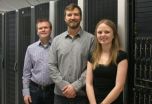(Press-News.org) MADISON, Wis. – Using more than 2 million images collected by NASA's orbiting Spitzer Space Telescope, a team of Wisconsin scientists has stitched together a dramatic 360 degree portrait of the Milky Way, providing new details of our galaxy's structure and contents.
The new composite picture (viewable at http://www.spitzer.caltech.edu/glimpse360), using infrared images gathered over the last decade, was unveiled today (March 20, 2014) at a TED conference in Vancouver. The galactic portrait provides an unprecedented look at the plane of our galaxy, using the infrared imagers aboard Spitzer to cut through the interstellar dust that obscures the view in visible light.
"For the first time, we can actually measure the large-scale structure of the galaxy using stars rather than gas," explains Edward Churchwell, a University of Wisconsin-Madison professor of astronomy whose group compiled the new picture, which looks at a thin slice of the galactic plane. "We've established beyond the shadow of a doubt that our galaxy has a large bar structure that extends halfway out to the sun's orbit. We know more about where the Milky Way's spiral arms are."
Lofted into space in 2003, the Spitzer Space Telescope has far exceeded its planned two-and-a-half-year lifespan. Although limited by the depletion of the liquid helium used to cool its cameras, the telescope remains in heliocentric orbit, gathering a trove of astrophysical data that promises to occupy a new generation of astronomers.
In addition to providing new revelations about galactic structure, the telescope and the images processed by the Wisconsin team have made possible the addition of more than 200 million new objects to the catalog of the Milky Way.
"This gives us some idea about the general distribution of stars in our galaxy, and stars, of course, make up a major component of the baryonic mass of the Milky Way," notes Churchwell, whose group has been collecting and analyzing Spitzer data for more than a decade in a project known as GLIMPSE (Galactic Legacy Infrared Midplane Survey Extraordinaire). "That's where the ballgame is."
The new infrared picture, known as GLIMPSE360, was compiled by a team led by UW-Madison astronomer Barb Whitney. It is interactive and zoomable, giving users the ability to look through the plane of the galaxy and zero in on a variety of objects, including nebulae, bubbles, jets, bow shocks, the center of the galaxy and other exotic phenomena. The image is being shown for the first time this morning on a large visualization wall installed by Microsoft at the TED conference.
The survey conducted by the Wisconsin group has also helped astronomers understand the distribution of the Milky Way's stellar nurseries, regions where massive stars and proto-stars are churned out.
"We can see every star-forming region in the plane of the galaxy," says Robert Benjamin, a professor of physics at the University of Wisconsin-Whitewater and a member of the GLIMPSE team.
"This gives us some idea of the metabolic rate of our galaxy," explains Whitney. "It tells us how many stars are forming each year."
Churchwell notes, too, that while Spitzer is helping astronomers resolve some of the mysteries of the Milky Way, it is adding new cosmological puzzles for scientists to ponder. For example, the infrared data gathered by the GLIMPSE team has revealed that interstellar space is filled with diffuse polycyclic aromatic hydrocarbon gas.
"These are hydrocarbons — very complicated, very heavy molecules with fifty or more carbon atoms," Churchwell says. "They are brightest around regions of star formation but detectable throughout the disk of the Milky Way. They're floating out in the middle of interstellar space where they have no business being. It raises the question of how they were formed. It also tells us carbon may be more abundant than we thought."
The new GLIMPSE composite image will be made widely available to astronomers and planetaria. The data is also the basis for a "citizen science" project, known as the Milky Way Project, where anyone can help scour GLIMPSE images to help identify and map the objects that populate our galaxy.
The data from the survey, Churchwell argues, will keep astronomers busy for many years: "It's still up there. It's still taking data. It's done what we wanted it to do, which is to provide a legacy of data for the astronomical community."
INFORMATION:
—Terry Devitt, 608-262-8282, trdevitt@wisc.edu
Dramatic new portrait helps define Milky Way's shape, contents
2014-03-20
ELSE PRESS RELEASES FROM THIS DATE:
Not only is she thinner than you ... her muscles work better, too
2014-03-20
Bethesda, MD (March 20, 2014)—We all know the type: The friend or colleague who stays slim and trim without much effort and despite eating the same high-calorie fare that causes everyone else to gain weight. As it turns out, the way the muscles of the inherently thin work may give them the edge.
Daily physical activity is an inherited trait with a strong association to how fat or thin a person is. Chaitanya K. Gavini et al. previously found that aerobic capacity is a major predictor of daily physical activity level among humans and laboratory animals. In their new study, ...
New semiconductor holds promise for 2-D physics and electronics
2014-03-20
From super-lubricants, to solar cells, to the fledgling technology of valleytronics, there is much to be excited about with the discovery of a unique new two-dimensional semiconductor, rhenium disulfide, by researchers at Berkeley Lab's Molecular Foundry. Rhenium disulfide, unlike molybdenum disulfide and other dichalcogenides, behaves electronically as if it were a 2D monolayer even as a 3D bulk material. This not only opens the door to 2D electronic applications with a 3D material, it also makes it possible to study 2D physics with easy-to-make 3D crystals.
"Rhenium ...
One-third of kids with obesity 'metabolically healthy,' study shows
2014-03-20
(Edmonton) Digits on a scale can help determine a child's weight, but their overall health status can be influenced by other factors such as physical activity, diet and screen time, according to new research from the University of Alberta and Alberta Health Services.
A study of 181 children with obesity aged eight to 17 years old showed that up to a third could be classified as "metabolically healthy," meaning they're not imminently at risk of developing insulin resistance—a precursor to Type 2 diabetes—high blood pressure, high cholesterol or other obesity-related diseases.
"It's ...
Pseudogap theory puts physicists closer to high temperature superconductors
2014-03-20
Physicists are one step closer to developing the world's first room-temperature superconductor thanks to a new theory from the University of Waterloo, Harvard and Perimeter Institute.
The theory explains the transition phase to superconductivity, or "pseudogap" phase, which is one of the last obstacles to developing the next generation of superconductors and one of the major unsolved problems of theoretical condensed matter physics.
Their work was published in this week's issue of the prestigious journal Science.
Superconductivity is the phenomenon where electricity ...
Potential lung cancer vaccine shows renewed promise
2014-03-20
(SACRAMENTO, Calif.) — Researchers at UC Davis have found that the investigational cancer vaccine tecemotide, when administered with the chemotherapeutic cisplatin, boosted immune response and reduced the number of tumors in mice with lung cancer. The study also found that radiation treatments did not significantly impair the immune response. The paper was published on March 10 in the journal Cancer Immunology Research, an American Association for Cancer Research (AACR) publication.
Though tecemotide, also known as Stimuvax, has shown great potential at times, the recent ...
Ancient clam gardens nurture food security
2014-03-20
A three-year study of ancient clam gardens in the Pacific Northwest has led researchers, including three from Simon Fraser University, to make a discovery that could benefit coastal communities' food production. PLOS ONE, a peer-reviewed science journal, has just published their study.
Amy Groesbeck, an SFU alumna, SFU professors Anne Salomon, an ecologist, and Dana Lepofsky, an archaeologist, and Kirsten Rowell, a University of Washington biologist are the authors.
The researchers discovered that ancient clam gardens made by Aboriginal people produced quadruple the ...
Genome-wide association studies mislead on cardiac arrhythmia risk gene
2014-03-20
Although genome-wide association studies have linked DNA variants in the gene SCN10A with increased risk for cardiac arrhythmia, efforts to determine the gene's direct influence on the heart's electrical activity have been unproductive. Now, scientists from the University of Chicago have discovered that these SCN10A variants regulate the function of a different gene, SCN5A, which appears to be the primary gene responsible for cardiac arrhythmia risk. The SCN10A gene itself plays only a minimal role in the heart, according to the study, published in the Journal of Clinical ...
Oregon physicists use geometry to understand 'jamming' process
2014-03-20
EUGENE, Ore. -- (March 20, 2014) -- University of Oregon physicists using a supercomputer and mathematically rich formulas have captured fundamental insights about what happens when objects moving freely jam to a standstill.
Their approach captures jamming -- the point at which objects come together too tightly to move -- by identifying geometric signatures. The payoff, while likely far down the road, could be a roadmap to preventing overfilled conveyor belts from stopping in factories, separating oil deposits trapped in sand, or allowing for the rapid, efficient transfer ...
Mayo Clinic researchers find genetic clue to irritable bowel syndrome
2014-03-20
ROCHESTER, Minn. — March 20, 2014 — Is irritable bowel syndrome (IBS) caused by genetics, diet, past trauma, anxiety? All are thought to play a role, but now, for the first time, researchers have reported a defined genetic defect that causes a subset of IBS. The research was published in the journal Gastroenterology.
Researchers estimate that approximately 15 to 20 percent of the Western world has IBS. It is a common disorder that affects the large intestine. Most patients with the disorder commonly experience symptoms of cramping, abdominal pain, bloating gas, diarrhea ...
Health insurance coverage increased ER use in Massachusetts
2014-03-20
WASHINGTON — The implementation of health care reform in Massachusetts – principally the expansion of health insurance coverage to nearly everyone in the state – was associated with a small but consistent increase in emergency department use, according to the findings of a study to be published online today in Annals of Emergency Medicine ("Increased Use of the Emergency Department After Health Care Reform in Massachusetts").
"This obviously has implications about what we can expect to see nationally as the roll-out of the Affordable Care Act continues," said Peter ...



